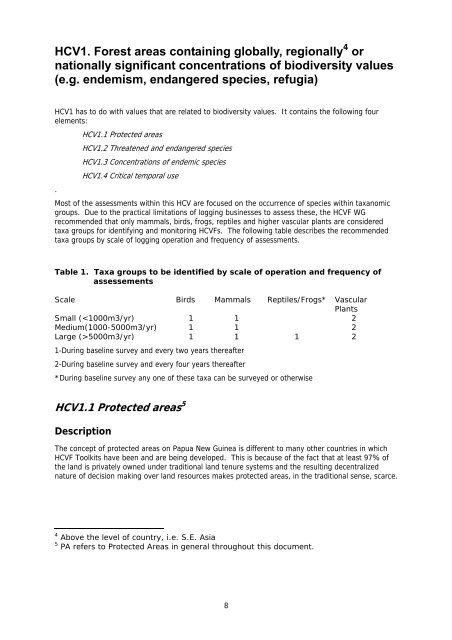A National Interpretation of the High Conservation Value Forest ...
A National Interpretation of the High Conservation Value Forest ...
A National Interpretation of the High Conservation Value Forest ...
Create successful ePaper yourself
Turn your PDF publications into a flip-book with our unique Google optimized e-Paper software.
HCV1. <strong>Forest</strong> areas containing globally, regionally 4 or<br />
nationally significant concentrations <strong>of</strong> biodiversity values<br />
(e.g. endemism, endangered species, refugia)<br />
HCV1 has to do with values that are related to biodiversity values. It contains <strong>the</strong> following four<br />
elements:<br />
.<br />
HCV1.1 Protected areas<br />
HCV1.2 Threatened and endangered species<br />
HCV1.3 Concentrations <strong>of</strong> endemic species<br />
HCV1.4 Critical temporal use<br />
Most <strong>of</strong> <strong>the</strong> assessments within this HCV are focused on <strong>the</strong> occurrence <strong>of</strong> species within taxanomic<br />
groups. Due to <strong>the</strong> practical limitations <strong>of</strong> logging businesses to assess <strong>the</strong>se, <strong>the</strong> HCVF WG<br />
recommended that only mammals, birds, frogs, reptiles and higher vascular plants are considered<br />
taxa groups for identifying and monitoring HCVFs. The following table describes <strong>the</strong> recommended<br />
taxa groups by scale <strong>of</strong> logging operation and frequency <strong>of</strong> assessments.<br />
Table 1. Taxa groups to be identified by scale <strong>of</strong> operation and frequency <strong>of</strong><br />
assessements<br />
Scale Birds Mammals Reptiles/Frogs* Vascular<br />
Plants<br />
Small (5000m3/yr) 1 1 1 2<br />
1-During baseline survey and every two years <strong>the</strong>reafter<br />
2-During baseline survey and every four years <strong>the</strong>reafter<br />
*During baseline survey any one <strong>of</strong> <strong>the</strong>se taxa can be surveyed or o<strong>the</strong>rwise<br />
HCV1.1 Protected areas 5<br />
Description<br />
The concept <strong>of</strong> protected areas on Papua New Guinea is different to many o<strong>the</strong>r countries in which<br />
HCVF Toolkits have been and are being developed. This is because <strong>of</strong> <strong>the</strong> fact that at least 97% <strong>of</strong><br />
<strong>the</strong> land is privately owned under traditional land tenure systems and <strong>the</strong> resulting decentralized<br />
nature <strong>of</strong> decision making over land resources makes protected areas, in <strong>the</strong> traditional sense, scarce.<br />
4 Above <strong>the</strong> level <strong>of</strong> country, i.e. S.E. Asia<br />
5 PA refers to Protected Areas in general throughout this document.<br />
8

















